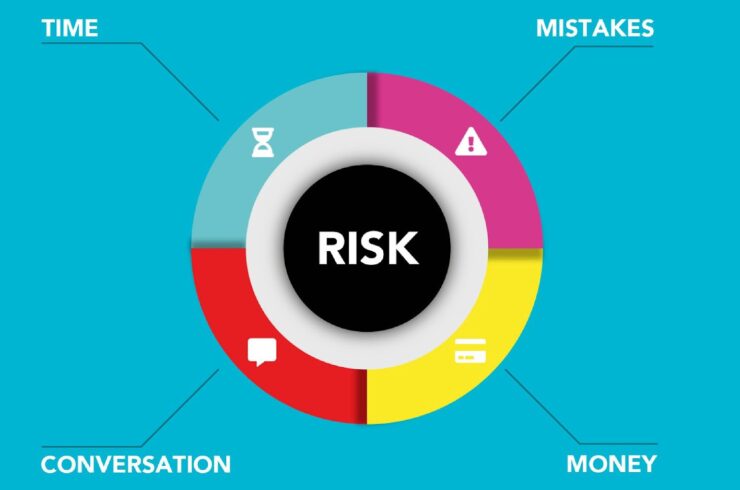You’ve hired the right team, set up a communication plan, and you’re confident that you can complete the project on time and within budget. But what happens when the unexpected occurs? How do you manage project risks so that they don’t jeopardize the success of your initiative?
The simplest thing can throw off your entire project schedule: a key team member gets sick and has to be out for a week, the new software doesn’t work with the company’s existing systems, or bad weather delays construction. Any of these risks could cause your project to fail.
That’s why it’s important to have a plan for managing project risks. By identifying potential risks early and taking steps to mitigate them, you can increase the chances of success for your project.
Let’s dig a little deeper into what project risk is, how to conduct a threat assessment, and some steps for managers.
What is project risk?
Put simply, risk is anything that could prevent your project from being successful. It’s important to remember that risk is not always a bad thing. Some risks can lead to positive outcomes for your project.
For example, if you’re launching a new product, there’s always the risk that it might not be well-received by customers. But if you’ve done your research and you’re confident in your product, that risk could lead to a big payoff. The key is to identify and assess risks so that you can make informed decisions about how to manage them.
Common project risks
While every project will have its own unique set of challenges, some risks seem to be universal. These are the things you have to watch out for every time, no matter how big or small the project is.
- Schedule delays: When team members are sick, there are delays in getting approvals, or unexpected events occur, the project can be severely delayed or even completely break down.
- Cost overruns: This can happen when materials cost more than expected, team members work overtime, or you have to make changes to the scope of the project.
- Scope creep: Speaking of scope, sometimes requirements are added to the project or stakeholders want changes to be made. It can cause schedule and cost overruns, as the project grows out of control.
- Poor communication: When team members are not kept in the loop, there’s a lack of clarity about roles and responsibilities, or communication channels are not being used effectively.
- Lack of resources: This can happen when team members are pulled away to work on other projects, you don’t have enough budget to hire new staff, or equipment is not available when you need it.
- Political changes: A change in leadership, a merger or acquisition, or new regulations are enacted that impact the project.
Of course, this is not an exhaustive list. It’s a risk manager’s job to detail every potential risk (or at least as many as they can), by considering all avenues of disruption.

What is project risk management?
Like anything else that can dramatically affect a business, risk must be managed carefully and strategically. Not all risks can or should be avoided – the goal is to manage them in a way that minimizes their impact.
Project risk management is the process of identifying, assessing, and responding to risks. It’s important to remember that risk management is not about eliminating all risks from a project (that’s impossible). Instead, it’s about making informed decisions about how to deal with risks so that they don’t jeopardize the success of your project.
There are four steps in the risk management process:
- Identify. The first step is to identify potential risks that could impact the project. This can be done through brainstorming sessions with the team, reviewing project documents, or conducting a stakeholder analysis.
- Prioritize. Once potential risks have been identified, it’s important to prioritize which ones need to be addressed. This can be done by considering the impact of the risk, the likelihood of it occurring, and any mitigation plans that are in place.
- Respond. Once you’ve assessed the risks, you can develop a plan for how to respond to them. This might involve developing contingency plans, setting up warning signs or triggers, or increasing communication with stakeholders.
- Monitor. Risk management is not a one-time exercise – it’s an ongoing process that should be monitored throughout the life of the project. This means regularly assessing risks, updating mitigation plans, and communicating with stakeholders.
By following these steps, you can develop a risk management plan that will help you to avoid or minimize the impact of risks on your project.
How to conduct a project risk assessment
A risk assessment encompasses the first two steps in any risk management process: identify and prioritize.
There are many different ways to conduct a risk assessment, but one common method is the SWOT analysis. This involves looking at the project’s strengths, weaknesses, opportunities, and threats. By considering all four of these factors, you can get a well-rounded view of the risks that might impact the project.
Another common method for conducting a risk assessment is the use of a risk register. This is simply a list of potential risks that can be used to track and monitor risks throughout the project.

Once they have been identified, each one must go through a rigorous assessment of:
- The probability of the risk occurring
- The potential impact of the risk
- Any mitigation plans that are in place
By conducting a thorough risk assessment, you can ensure that you have considered all potential risks and that you are prepared to respond to them.
Types of risks in project management
Generally, there are four categories of risks that can disrupt any project.
- Schedule risks: These risks arise when there are delays or disruptions to the project timeline. This could be due to issues like unrealistic deadlines or changes in the team’s availability.
- Cost risks: Ballooning costs could threaten to shut down an entire project and could be due to things like material shortages, unanticipated fees, or scope creep.
- Quality risks: Low quality is when the project does not meet the required or anticipated standards. This could be due to things like poor workmanship, incorrect materials, or unrealistic expectations.
- Customer satisfaction risks: This is when the customer is not happy with the final product. This could be due to things like a lack of communication, unrealistic expectations, or poor quality.
By understanding these different types of risks, you can start to put together a plan for how to mitigate them.
Risk management in project management
Sometimes, it is hard to know where risk management fits into the overall project management hierarchy. Who is completing it? When is it completed? How do you ensure that it is being done properly?
Risk management is an important part of any project and should be completed by the project manager. It should be started early on and revisited throughout the lifecycle as new risks present themselves.
Three steps to managing project risks
Now that you know what risk is, it’s time to learn how to manage it. Here are three steps you can take:
1. Conduct a threat assessment
The first step in managing project risks is to identify potential threats to your project. This can be done through a variety of methods, including interviews, questionnaires, and workshops.

Here is an example:
Your team is tasked with creating and implementing a new customer service solution on the company website. You’ve been assigned the project and you’re ready to get started. But before you do, you want to make sure that you understand all of the risks associated with the project.
You decide to conduct a series of interviews with key stakeholders. You speak with the head of customer service, the IT department, and human resources. From these conversations, you identify a few potential risks:
- The customer service team is resistant to change and may not use the new system
- The IT department is concerned about the impact the new system will have on the existing company architecture
- HR is worried that the launch of the new system will be delayed because one of the technicians is planning parental leave
With these risks identified, you can now take steps to mitigate them.
2. Create a risk management plan
You have identified three potential risks and now you need to come up with a plan to address them. This is where you will detail how you will mitigate each risk.
For example, you may decide to create a training program for the customer service team so that they are comfortable using the new system.
You may also work with the IT department to ensure that the new system will not cause any issues with existing company systems. And finally, you may create a plan for launching the new system in phases so that if the technician goes on parental leave, it will not delay the entire project.
3. Monitor and adjust your plan as needed
It’s not enough to just put those plans in place and wash your hands of the situation. You need to monitor the risks and adjust as needed.
For example, if you find that the customer service team is still struggling to use the new system, you may need to provide additional training or support. If the IT department raises new concerns, you’ll need to address those as well.
And if the launch date for the new system gets pushed back, you’ll have to adjust your plan accordingly or hire a freelance technician to help finalize the build.
Final thoughts
At the end of the day, managing project risks is all about being proactive. By identifying potential risks early and taking steps to mitigate them, you can increase the chances of success for your project.
